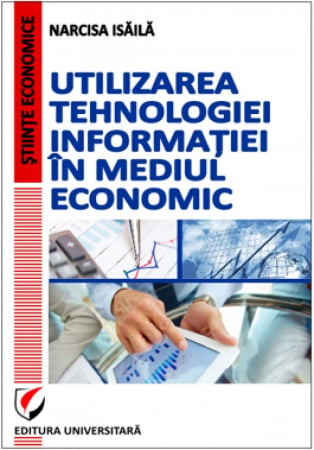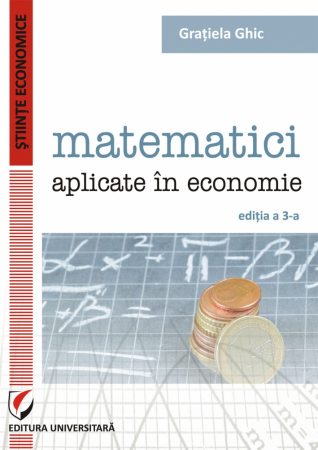6359.png) Financial accounting of the company. Theoretical and practical approach. 6th edition, revised and added
Financial accounting of the company. Theoretical and practical approach. 6th edition, revised and added
6359.png)
ISBN: 978-606-28-1428-1
DOI: https://doi.org/10.5682/9786062814281
Publisher year: 2022
Edition: 6th edition, revised and added
Pages: 574
Publisher: Editura Universitară
Author: Victor Munteanu - Coordonator
- Download (1)
- Authors
- Content
- More details
- Reviews (0)
-
Financial accounting of the company. Theoretical and practical approach. 6th edition, revised and added
Download
Conf. univ. dr. MARILENA ZUCA
Conf. univ. dr. GABRIEL CUCUI
Lector univ. dr. ALICE TINTA
Drd. FLORIN GHEORGHE
CHAPTER 1: THE BASICS OF ORGANIZING FINANCIAL ACCOUNTING / 15
Definition of financial accounting / 15
Elements regarding the normalization and regulation of financial accounting / 19
Definition, types and concepts of accounting normalization / 19
Accounting standardization devices in Romania / 20
1.2.2.1. Accounting law no. 82/1991, republished / 21
1.2.2.2. Accounting regulations regarding the individual annual financial statements and the consolidated annual financial statements (Order M.F.P. no. 1802 / December 2014) / 22
IASB General Conceptual Framework. Definition, purpose and scope / 23
Define, purpose / 23
Scope / 24
1.3. Objective of financial statements (reporting) / 25
1.4. Qualitative characteristics of financial information and true image / 27
1.4.1. Qualitative characteristics / 27
1.4.1.1. Limiting aspects of financial-accounting information / 29
1.4.2. Real and correct image. Faithful image / 31
1.4.2.1. Financial-accounting information: the essential component and condition of the Financial Accounting Information System (SIFC) of the entity / 31
1.4.2.2. The role of financial-accounting information in economic, legal, fiscal, social / 32
1.4.2.3. Accounting conceptual framework: reference matrix of financial-accounting information / 33
1.4.2.4. Financial-accounting information: product of economic and legal acts and facts from the entity / 33
1.4.2.5. Financial-accounting information: result and consequence of professional reasoning / 34
1.4.2.6. Relevant financial-accounting information - the fundamental component in the adoption of the managerial decision / 34
1.4.3. Qualitative characteristics of financial - accounting information / 35
1.4.4. True image or a true and fair presentation of the financial position and financial performance of the entity / 38
1.4.5. Quality financial-accounting information - matter of the existence and performance of the Financial Accounting Information System (S.I.F.C.) created at the level of the entity / 40
1.5. Financial reporting and external communication - informational values of financial statements (reports) / 42
1.5.1. Objectives of financial statements (reports) / 42
1.5.2. Financial statements (reports) - delimitations and references / 44
1.5.3. Financial statements (reports) within the meaning of IFRS / 45
1.5.3.1. Balance sheet / 45
1.5.3.2. Profit and loss account / 46
1.5.3.3. Statement of changes in equity / 47
1.5.3.4. Cash flow statement / 48
1.5.3.5. Explanatory notes / 51
1.5.4. Financial statements / annual accounts in accordance with the 4th EEC / 51 Directive
1.5.4.1. Balance sheet / 51
1.5.4.2. Profit and loss account / 57
1.5.4.3. Annex to the balance sheet or notes to the accounts in accordance with Directive IV of EEC / 58
1.5.5. The financial statements regulated in the accounting from ROMANIA / 59
1.5.1.1. Balance sheet - Statement of the financial position of the entity / 59
1.5.5.2. Profit and loss account - The financial performance of the entity / 62
1.5.5.3. Statement of changes in equity / 63
1.5.5.4. Cash flow statement / 65
1.5.5.5. Explanatory notes to the annual financial statements / 68
1.6. Users of financial statements / 72
CHAPTER 2: CAPITAL ACCOUNTING / 74
2.1. Content and structure of capital / 74
2.2. Organization of capital accounting / 75
2.2.1. Objectives and factors of organizing capital accounting / 75
2.2.2. Organizing the system of documents and the operative evidence of the capitals / 76
2.2.3. Current valuation of capital / 78
2.2.4. The system of accounts used in the organization of capital accounting / 82
2.3. Equity accounting / 83
2.3.1. Share capital accounting / 83
2.3.1.1. Accounting for share capital operations / 84
2.3.1.2. Accounting for operations regarding the increase of the share capital / 89
2.3.1.3. Accounting for operations regarding the reduction of the share capital / 92
2.3.2. Accounting for capital premiums / 97
2.3.3. Revaluation reserve accounting / 103
2.3.4. Accounting for legal reserves and other reserves / 104
2.3.5. Accounting for own shares / 106
2.3.6. Accounting for results / 107
2.3.6.1. Accounting for the carried forward result / 107
2.3.6.2. Accounting for the result of the exercise / 109
2.3.7. Accounting for gains or losses related to the issue, redemption, sale, free transfer or cancellation of equity instruments / 111
2.4. Accounting for provisions / 112
2.4.1. Accounting for provisions for litigation / 113
2.4.2. Accounting for provisions for guarantees granted to clients / 114
2.4.3. Accounting for provisions for decommissioning of fixed assets and other similar actions related to them / 116
2.4.4. Accounting for restructuring provisions / 117
2.4.5. Accounting for provisions for pensions and similar obligations / 119
2.4.6. Accounting for tax provisions / 119
2.4.7. Accounting for provisions for termination of employment contract / 119
2.4.8. Accounting for other provisions / 119
2.4.9. Evaluation of provisions / 120
2.5. Accounting for loans and similar liabilities / 121
2.5.1. Accounting for loans from bond issues / 121
2.5.2. Accounting for long - term bank loans / 124
2.5.3. Accounting for other loans and similar liabilities / 127
CHAPTER 3: ACCOUNTING OF FIXED ASSETS / 31
3.1. Delimitations and structures regarding fixed assets / 131
3.2. Organization of fixed assets accounting / 133
3.2.1. Objectives and factors of organizing the accounting of fixed assets / 133
3.2.2. Primary documents regarding fixed assets / 133
3.2.3. Subsystem of fixed assets accounts / 136
3.2.4. Valuation of fixed assets / 136
3.3. Accounting for intangible assets / 139
3.3.1. Characterization of intangible assets; recognition and evaluation / 139
3.3.2. Accounting for start - up expenses / 140
3.3.3. Development expenditure accounting / 142
3.3.4. Accounting for fixed assets in concessions, patents, licenses, trademarks, rights and similar assets / 146
3.3.5. Goodwill accounting / 152
3.3.6. Accounting for other intangible assets / 155
3.4. Accounting for property, plant and equipment / 156
3.4.1. Accounting for land and landscaping / 157
3.4.1.1. Land accounting proper / 157
3.4.1.2. Landscaping accounting / 159
3.4.2. Fixed assets accounting / 161
3.4.2.1. Delimitations and structures regarding fixed assets / 161
3.4.2.2. Organization of fixed assets accounting / 163
3.4.2.3. Fixed assets movement accounting / 170
A. Accounting for transactions in fixed assets inflows / 170
B. Accounting for transactions regarding fixed assets outflows / 181
C. Accounting for leased fixed assets / 192
3.5. Real estate investment accounting / 193
3.6. Accounting for productive biological assets / 195
3.7. Accounting for fixed assets under construction / 196
3.7.1. General characterization of fixed assets under construction / 196
3.7.2. Accounting for tangible assets under construction / 196
3.8. Accounting for financial assets / 197
3.8.1. Definitions and structures regarding financial assets / 197
3.8.2. Recognition and evaluation of financial assets / 198
3.8.3. Accounting for transactions in financial assets in securities / 199
3.9. Depreciation accounting for fixed assets / 203
3.9.1. Depreciation of fixed assets / 204
3.9.1.1. Definition, role and calculation methods regarding depreciation / 204
3.9.1.2. Depreciation accounting / 214
3.9.2. Accounting for adjustments for depreciation or impairment of fixed assets / 217
3.9.2.1. General characterization of adjustments for depreciation of fixed assets / 217
3.9.2.2. Accounting for adjustments for impairment of intangible assets / 218
3.9.2.3. Accounting for adjustments for impairment of fixed assets / 219
3.9.2.4. Accounting for adjustments for impairment of financial assets / 219
3.9.2.5. Accounting for adjustments for depreciation of fixed assets in progress / 220
CHAPTER 4: ACCOUNTING FOR CURRENT ASSETS / 214
4.1. Definitions and delimitations regarding current assets / 221
4.2. Inventory accounting / 221
4.2.1. Definition and recognition of stocks / 222
4.2.2. Objectives and factors of stock accounting organization / 225
4.2.3. Stock valuation / 226
4.3. Organization of the information-accounting system of stocks / 237
4.4. Organization of analytical accounting of inventories / 242
4.5. Organization of synthetic stock accounting / 247
4.6. Accounting for raw materials and consumables / 251
4.7. Production accounting in progress / 265
4.8. Product Accounting / 268
4.8.1. Organization of product accounting / 268
4.8.2. Accounting for semi-finished products / 270
4.8.3. Accounting for finished products / 274
4.8.4. Accounting for residual products / 278
4.9. Inventory accounting for third parties / 278
4.10. Accounting for biological assets of the nature of stocks / 281
4.11. Accounting for goods / 284
4.12. Packaging inventory accounting / 292
4.12.1. The notion and classification of packaging / 292
4.12.2. Packaging accounting organization / 294
4.12.3. Accounting for main packaging operations / 297
4.13. Accounting for adjustments for depreciation of inventories and production in progress / 304
CHAPTER 5: ACCOUNTING OF THIRD PARTY SETTLEMENTS / 312
5.1. Definition, content and structure of settlements with third parties / 312
5.2. Objectives and factors of organizing the accounting of settlements with third parties / 315
5.3. Recognition and measurement of debts and receivables / 316
5.4. The information-accounting system of debts and receivables / 317
5.4.1. Primary documents used / 317
5.4.2. Operational evidence of debts and receivables / 318
5.4.3. Analytical accounting of debts and receivables / 318
5.4.4. The system of synthetic accounts used to reflect in accounting the settlements with third parties / 318
5.5. Accounting for transactions with settlements with suppliers / 319
5.6. Accounting for transactions regarding settlements with customers / 331
5.7. Accounting for staff settlements and similar operations / 341
5.8. Accounting for settlements with social insurance and social protection / 353
5.9. Accounting for settlements with the state budget and special funds / 357
5.9.1. Profit / income tax settlements / 357
5.9.2. Accounting for settlements regarding value added tax / 360
5.9.2.1. Value added tax - definition, scope, generating fact, basis and tax rates, settlement / 360
5.9.2.2. Objectives and factors of organizing the accounting of value added tax / 367
5.9.2.3. Organization of value added tax accounting / 367
5.9.2.4. Subsystem of accounts for value added tax / 372
5.9.2.5. Applications regarding the accounting of value added tax settlement operations / 379
5.9.2.6. Value added tax settlement / 385
5.9.3. Subsidy settlements / 388
5.9.4. Settlements regarding other taxes, fees and assimilated payments / 388
5.9.5. Accounting for settlements with special funds / 389
5.9.6. Other debts and receivables with the state budget / 390
5.10. Accounting for settlement operations within the group with shareholders / associates / 391
5.11. Settlement accounting with various debtors and creditors / 392
5.11.1. Settlements with various debtors / 392
5.11.2. Settlements with various creditors / 395
5.12. Accounting of operations regarding the accounts of subsidies, regularization and assimilated / 396
5.12.1. Expenses recorded in advance / 397
5.12.2. Revenues recorded in advance / 399
5.12.3. Settlements from operations under clarification / 400
5.12.4. Investment grants / 401
5.13. Accounting for adjustments for impairment of receivables / 403
CHAPTER 6: TREASURY ACCOUNTING / 406
6.1. Delimitations and accounting structures regarding the entity's treasury / 406
6.1.1. Definition, concepts, structures regarding the entity 's treasury / 406
6.2. Organization of treasury accounting / 418
6.2.1. The objectives of the accounting of the treasury of the economic entities / 418
6.2.2. Treasury in the financial-accounting circuit of economic entities / 419
6.3. Short - term investment accounting / 426
6.3.1. Characteristics and structure of short - term investments / 426
6.3.2. Short - term investment evaluation / 428
6.3.3. Accounting for shares held in affiliated entities / 428
6.3.4. Accounting for short-term investment in bonds / 429
6.3.5. Accounting for green certificates / 435
6.3.6. Accounting for other short - term investments and similar receivables / 436
6.4. Accounting for receivables / 437
6.4.1. Checks receivable / 437
6.4.2. Cash effects / 438
6.4.3. Discounted effects / 438
6.5. Accounting for collection and payment operations performed through bank accounts / 439
6.5.1. Bank accounts in lei / 439
6.5.2. Bank accounts in foreign currency / 442
6.5.3. Amounts being settled / 446
6.6. Accounting for short - term bank loans / 447
6.7. Interest accounting on cash and short-term bank loans / 448
6.8. Accounting for cash operations and other treasury values / 450
6.8.1. Cash operations accounting / 450
6.9. Accounts receivable and cash advances / 454
6.9.1. The letters of credit / 454
6.9.2. Treasury advances / 455
6.10. Particularities regarding the accounting of internal transfers / 457
6.11. Accounting for adjustments for impairment of treasury accounts / 459
6.12. Place / 460
CHAPTER 7: FINANCIAL ACCOUNTING OF EXPENDITURE, INCOME AND INCOME / 463
A. FINANCIAL ACCOUNTING OF EXPENDITURE / 463
7.1. Concept, content, recognition and structure of expenditure / 463
7.2. Objectives and factors of organizing the accounting of expenses / 465
7.2.1. Organization of primary documentation / 466
7.2.2. Organization of synthetic accounting of expenses / 466
7.3. Accounting for operating expenses / 469
7.3.1. Inventory accounting for stocks / 469
7.3.1.1. Expenditure on raw materials / 469
7.3.1.2. Expenditure on consumables / 470
7.3.1.3. Expenditures on materials of the nature of inventory items / 471
7.3.1.4. Expenditure on non - stocked materials / 472
7.3.1.5. Energy and water expenditure / 472
7.3.1.6. Expenditures on biological assets of the nature of stocks / 473
7.3.1.7. Expenditure on goods / 473
7.3.1.8 Expenditure on packaging / 474
7.3.2. Accounting for expenses with services performed by third parties / 475
7.3.2.1. Maintenance and repair expenses / 475
7.3.2.2. Fees, rents and rents / 476
7.3.2.3. Expenses with insurance premiums / 477
7.3.2.4. Expenditures on studies and research / 478
7.3.3. Accounting for expenses with other services performed by third parties / 478
7.3.3.1. Expenditures with collaborators / 478
7.3.3.2. Expenses on commissions and fees / 479
7.3.3.3. Protocol, advertising and publicity expenses / 479
7.3.3.4 Expenditure on transport of goods and personnel / 480
7.3.3.5 Travel, secondment and transfer expenses / 481
7.3.3.6. Postal charges and telecommunications charges / 482
7.3.3.7. Expenditures on banking and similar services / 483
7.3.3.8. Other expenses with services performed by third parties / 484
7.3.4. Accounting for expenses with taxes, fees and assimilated payments / 484
7.3.4.1. Expenditures with other taxes, fees and assimilated payments / 484
7.3.5. Personnel expense accounting / 486
7.3.5.1. Staff salaries / 486
7.3.5.2. Expenditures on insurance and social protection / 487
7.3.6. Accounting for other operating expenses / 488
7.3.6.1. Accounting for expenses with environmental protection / 488
7.3.6.2. Accounting for losses from miscellaneous receivables and payables / 489
7.3.6.3. Expenses from revaluation of tangible assets / 489
7.3.6.4. Other operating expenses / 489
7.3.7. Accounting for operating expenses in respect of depreciation, provisions and adjustments for impairment or impairment / 490
7.4. Accounting for expenses from financial activity / 491
7.4.1. Expenditure on losses on receivables related to participations / 491
7.4.2. Expenditures on assigned financial investments / 492
7.4.3. Expenses from exchange rate differences / 493
7.4.4. Interest expenses / 493
7.4.5. Expenditure on discounts granted / 494
7.4.6. Financial expenses related to depreciation, provisions and adjustments for impairment / 494
7.4.7. Other financial expenses / 495
7.5. Accounting for income tax expenses / 495
7.6. Accounting for settlement of expenses / 496
B. FINANCIAL ACCOUNTING OF REVENUE / 497
7.7. The concept, content, recognition and structure of income / 497
7.8. Objectives and factors of income accounting organization / 498
7.9. Organization of financial accounting of income / 501
7.9.1. Organization of primary documentation / 501
7.9.2. Organizing synthetic income accounting / 502
7.10. Accounting for operating income / 502
7.10.1. Sales revenue accounting (net turnover) / 502
7.10.1.1. Revenues from the sale of finished products, agricultural products and biological assets of the nature of stocks / 502
7.10.1.2. Proceeds from the sale of semi - finished products / 503
7.10.1.3. Revenue from the sale of residual products / 504
7.10.1.4. Revenue from services rendered / 505
7.10.1.5. Revenues from studies and research / 505
7.10.1.6. Revenues from royalties, management locations and rents / 506
7.10.1.7. Revenue from the sale of goods / 506
7.10.1.8. Income from miscellaneous activities / 507
7.10.2. Revenue accounting for product inventory costs / 507
7.10.3. Accounting for income from the production of fixed assets / 513
7.10.3.1. Revenues from the production of intangible assets / 514
7.10.3.2. Revenues from the production of tangible fixed assets / 514
7.10.3.3. Real estate investment income / 515
7.10.4. Accounting for operating grants / 515
7.10.5. Accounting for other operating income / 516
7.10.5.1. Revenue from reactivated receivables and miscellaneous debtors / 516
7.10.5.2. Revenues from revaluation of property, plant and equipment / 516
7.10.5.3. Other operating income / 517
7.10.6. Accounting for income from provisions, amortization and adjustments for impairment or impairment in respect of operating activity / 517
7.11. Accounting for income from financial activity / 518
7.11.1. Income from financial fixed assets / 519
7.11.2. Income from other short - term investments / 519
7.11.3. Income from ceded financial investments / 519
7.11.4. Income from exchange rate differences / 520
7.11.5. Interest income / 521
7.11.6. Revenues from discounts obtained / 522
7.11.7. Other financial income / 522
7.11.8. Financial income from depreciation and amortization adjustments / 523
7.12. Revenue settlement accounting / 524
C. ACCOUNTING OF EXERCISE RESULT / 524
7.13. Determination of the result / 524
7.14. Reflection in accounting of the determination of the financial result / 525
7.15. Calculation, registration and settlement of profit tax / 528
7.16. Accounting for the distribution of the result for the year I / 533
CHAPTER 8: CLOSING WORKS FOR THE FINANCIAL YEAR / 537
8.1. Delimitations regarding the closing works of the financial year / 537
8.2. Preparatory work for the preparation of financial statements / 529
8.2.1. Establishing the balance of accounts before inventory / 539
8.2.2. General inventory of assets and liabilities / 541
8.2.3. Accounting for settlement operations / 543
a. Operations regarding the regularization of inventory pluses and minuses / 543
b. Depreciation operations / 545
c. Impairment and impairment adjustments / 546
d. Resumption operations / 548
e. Operations regarding exchange rate differences / 548
f. Operations regarding the time delimitation of expenses and revenues / 549
8.2.4. Balance of accounts by inventory / 550
8.2.5. Determining the result of the exercise / 552
8.2.6. Writing financial statements / 554
A. Balance / 555
B. Profit and loss account / 558
C. Statement of changes in equity / 569
D. Statement of cash flows / 570
E. Explanatory notes / 570
BIBLIOGRAPHY / 572
Accounting issues - addressed in the paper, is opposable to economic entities, each chapter highlighting the objectives and factors of material and formal organization of accounting in a given field.
From the accounting issues of the company, the one regarding the organization and normalization of financial accounting, capital accounting, fixed assets, current assets, settlements with third parties, treasury, income and expenses, off-balance sheet elements of economic entities, about the closing works of the year was chosen and presented. financial and accounting reporting, as well as about the accounting of other economic operations.
The content of the paper integrates the significant elements, in the field of accounting, of the European directives and the International Financial Reporting Standards (IFRS), as well as of the Order No. 1802 / December 2014 of the Minister of Public Finance, for approving the accounting regulations regarding the individual annual financial statements. consolidated annual financial statements.
Relating to the need of the university and the accounting profession, the book offers the theoretical, methodological foundations and practical references regarding the financial accounting in Romania, in the conditions of the integration of the recent accounting regulations and of the International Financial Reporting Standards.
The paper is addressed, first of all, to those who, in high schools, faculties or other forms of professional training, study accounting.
It is intended, secondly, for accounting practitioners, accountants, economists, accountants, financial auditors, financial analysts and other specialists who want to deepen the informational value of accounting.
All of them are offered the issue of organization, management and accounting technique in the concept of Romanian standardization and application, based on the normative acts in the field elaborated in our country.
When writing the paper we used a rich legislation and foreign literature, but especially local. We thank the Romanian normalizers for their efforts to create and then perfect a competitive accounting system.
We also appreciate the interest and professional competence of specialists in education, research and practice in the field of accounting for books, studies and our own views that have seen the light of day and that have been of real use to us in writing the paper. We enjoyed the qualified support of the publishing house, the printing house, the editor and the word processors, who took care of the operative preparation and the appearance in the best conditions of the work, for which we thank them.
We thank, a priori, our readers, pupils and students, teachers, specialists who will have the patience and interest to read and use this book.
We are aware that this paper can be improved, that it can be the subject of critical reflections, suggestions and proposals. Therefore, we will be grateful to all for the submitted recommendations that we are waiting for with due attention and that we will receive with pleasure and distinguished consideration and we will consider them in a possible new edition.
Bucharest, March 2022
Authors

![Financial accounting of the company. Theoretical and practical approach. 6th edition, revised and added [1] Financial accounting of the company. Theoretical and practical approach. 6th edition, revised and added [1]](https://gomagcdn.ro/domains/editurauniversitara.ro/files/product/large/munteanu-victor_contab-fin-a-intreprinderii-ed6_bt-6457-5813.jpg)














